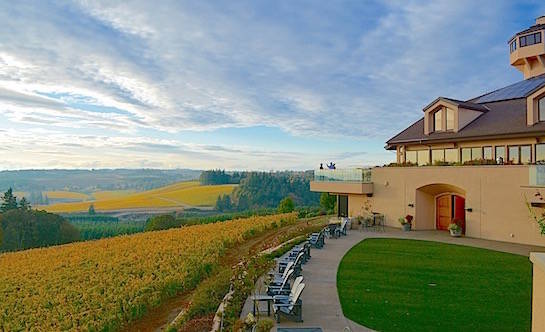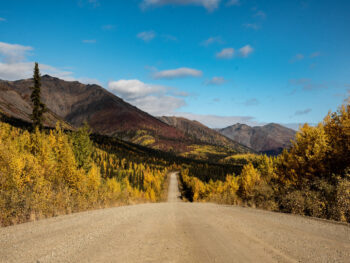Vacay.ca occasionally publishes content featuring destinations outside of Canada. In time for US Thanksgiving, our editor Adrian Brijbassi ventures to Oregon Wine Country to profile its booming viticulture and wine tourism scene.
TURNER, OREGON — Years before vinifera grapes were planted in British Columbia’s Okanagan Valley, Canadians were making an impact on another emerging wine region in the west coast. Oregon’s Willamette Valley, a haven for Pinot Noir, owes its viticulture roots to Californians migrating north, but farmers and oenologists who travelled south have also played a role in developing what is now the fourth-largest wine-producing state in the United States. Oregon has 725 wineries — about twice as many as in BC — and some of those businesses have strong ties to Canada.

Among them is Willamette Valley Vineyards, one of the largest and most well-known wineries in Oregon. Its founder, Jim Bernau, is the great-grandson of a Quebec-born homesteader and chief trading officer of the Hudson’s Bay Company. In 1821, Pierre Pambrun and his Manitoban wife, Kitty, were stationed in the Oregon Territory and ended up settling on the property that’s in the heart of the Willamette Valley. Although Pambrun owned farmland, he wasn’t growing wine grapes. Few people did and any incentive to do so ended when alcohol-making activity in the state was banned during the Prohibition era of the 1920s and ’30s. No one attempted to grow vinifera in Oregon again until the early 1960s, when a California winemaker named Richard Sommer arrived with the intention to plant pinot noir — the so-called “heartbreak” grape that is difficult to produce but very much worthwhile if you can get it right. Pinot Noir wines are defined by distinctive characteristics most often linked to Burgundy in France. Growing them in a wet climate on the Pacific coast of North America seemed unlikely, but Sommer had done his research and was convinced the grape would tolerate Oregon, and vice versa.
Through circumstance, he hired Bernau’s father, a lawyer, to make sure he was compliant with Oregon law before he established the state’s first post-Prohibition winery. Bernau’s first taste of wine came from his father and his enthusiasm for what Sommer had brought to their part of the world.

“I was 10 years old when the light bulb went off,” Bernau recalls. “My dad was just a big believer in the natural attributes of our land here in Oregon. He also had a client who was the very first immigrating California winemaker. Dad was a cheerleader for his new client who needed help. He received the first license to make wine in the state since Prohibition and he got a bottle for us. He shared it at dinner table with my brother and me. That was it. That’s when I started thinking this was something I had to do and could do.”
Drinking In the Charms of Oregon Wine Country
What Bernau achieved is stupendous. He established the first community-owned winery in North America. Shares of Willamette Valley Vineyards trade on the NASDAQ stock exchange and anyone who owns a minimum of 100 shares (valued at about $7.35 USD per share) receives numerous benefits of ownership. The wines are also brilliant. The Estate Reserve Pinot Noir is dense with flavour and a texture of velvet that lingers on the tongue. The 2016 Chardonnay was dubbed by Wine & Spirits Magazine as the “year’s best” from the US in that grape varietal. The winery also stocks wines named after Bernau’s great-grandfather. The Pambrun line creates three wines — Merlot, Cabernet Sauvignon, and a blend of Bordeaux grapes. They’re silky and elegant red gems with the characteristics of classic French wines.
Willamette Valley Vineyards’ Canadian connection doesn’t end with Bernau or his family. The winery’s assistant winemaker, Gabrielle Prefontaine, is from Quebec and has apprenticed at Road 13 Vineyards, the esteemed Okanagan Valley operation that in 2018 was again named Canada’s winery of the year.
“In Oregon there is a sense of cooperation and of working together. There is definitely this notion to promote the region before you promote yourself. I see that a lot here,” says Prefontaine, who has worked in wine-growing regions in Australia, France, and elsewhere. Along with the camaraderie, she has noticed the exuberance for the level of wine-making and wine appreciation in the area.

The Willamettete Valley is a lush, pastoral region just one hour by car south of Portland. It’s a road-tripper’s dream with charming towns filled with tasting rooms, excellent restaurants influenced by Portland’s culinary talents, and boutique shops and hotels. Its wines have become internationally recognized, despite disbelief early on from the industry establishment. Veteran wine operators in Oregon, such as Bernau, fondly recall the watershed moment when Oregon stunned the world with its Pinot Noir. In 1979, Eyrie Vineyards left the wine industry in Paris apoplectic when its 1975 Pinot Noir placed third in an international blind tasting event traditionally dominated by French wines from long-established producers. The result shocked the French so much their industry leaders opted to conduct the tasting again, moving the location from Paris to the heart of Burgundy. This time, the Eyrie Pinot Noir did even better, placing second, and catapulting Oregon’s wines to new stature.
Now, each summer, the Willamette Valley hosts the International Pinot Noir Celebration, a three-day fest of Bacchanalia and wine education. Among the participating wineries in the 2018 edition were Willamette Valley Vineyards, Eyrie Vineyards, and Lavinea, which is owned by another Canadian from Quebec.

Isabelle Meunier has turned her small vineyard into a connoisseur’s favourite. In 2015, Wine Spectator named her 2012 La Source Pinot Noir the third-ranked wine in the world.
“She’s one of the most accomplished wine-makers in terms of reviews and ratings in Oregon history,” Bernau says of Meunier, demonstrating that root-for-your-neighbour attitude that permeates the region. “It’s interesting to think of the influence that Canadians have had in the Oregon wine industry. It’s kind of cool, isn’t it?”
More About Visiting Willamette Valley Vineyards

Location: 8800 Enchanted Way SE, Turner, Oregon (see map below)
Getting There: Air Canada is among the airlines that offer direct flights to Portland from major Canadian cities. After arriving in Portland International Airport, often cited as the best airport for travellers in North America, pick up your rental car and drive south on Interstate 5 for about one hour until you reach Exit 248. The property is a short drive from that exit.
Where to Stay: The property includes two immaculate suites (with plans for more in the works). The suites overlook the vineyards and if you’re lucky enough to be there in fall harvest season, the colours glow far into the distance. Nightly Rates: Depending on the season and suite, prices for the first night start at $345 and drop to $195 for each additional night. The rate includes a private wine tasting and winery tour for two, and a $150 credit to purchase wines at the vineyard. Check here for more details.
Where to Dine: Willamette Valley Vineyards operates an on-site restaurant in its spectacular tasting room. Be sure to try the Mushroom Burger ($18), which includes a half-pound of Wagyu beef and is served with truffle fries. The restaurant is open from 11 am-6 pm (7:30 pm on Fridays).
Website: www.wvv.com











 B.C. wines hold their own against international competition
B.C. wines hold their own against international competition